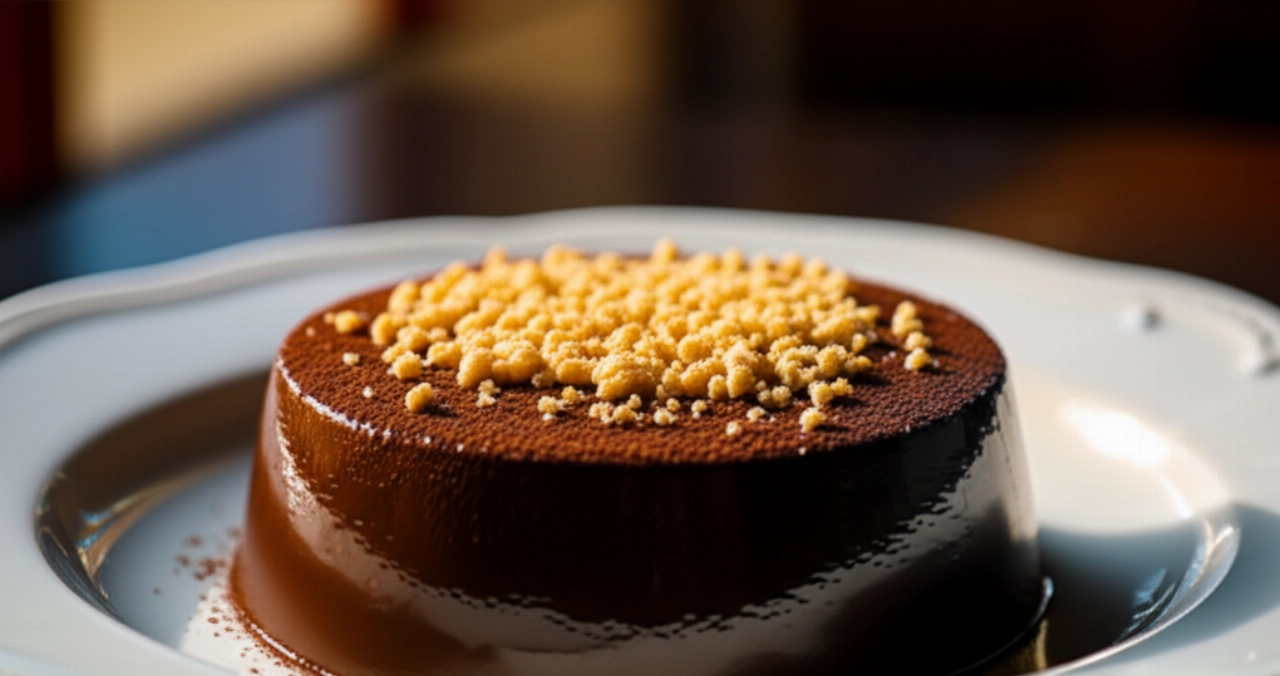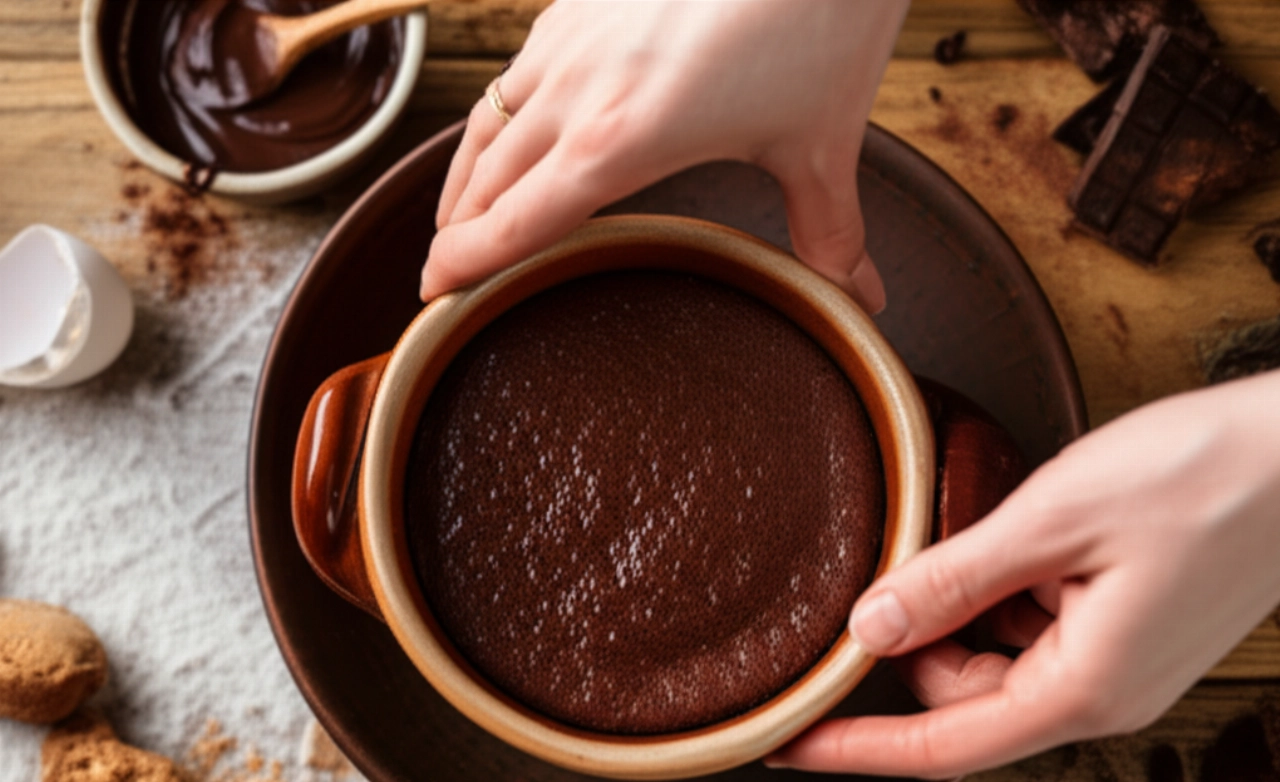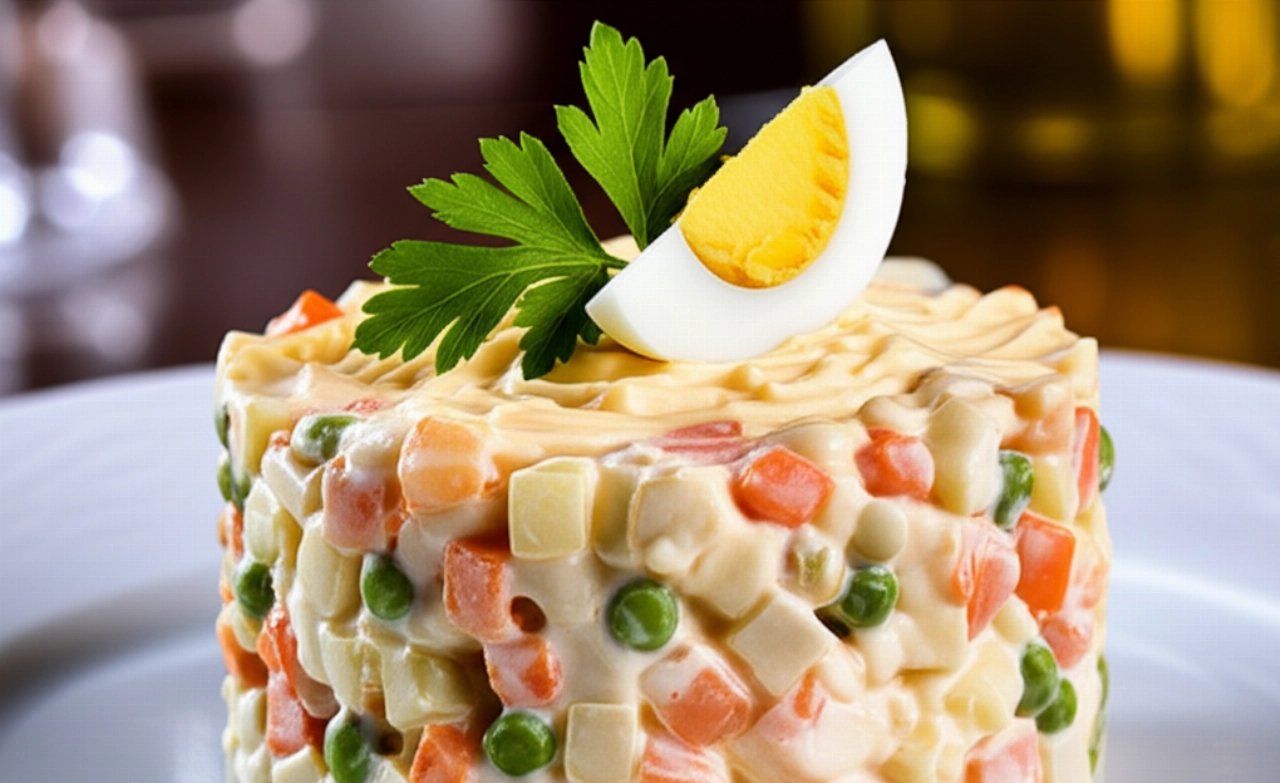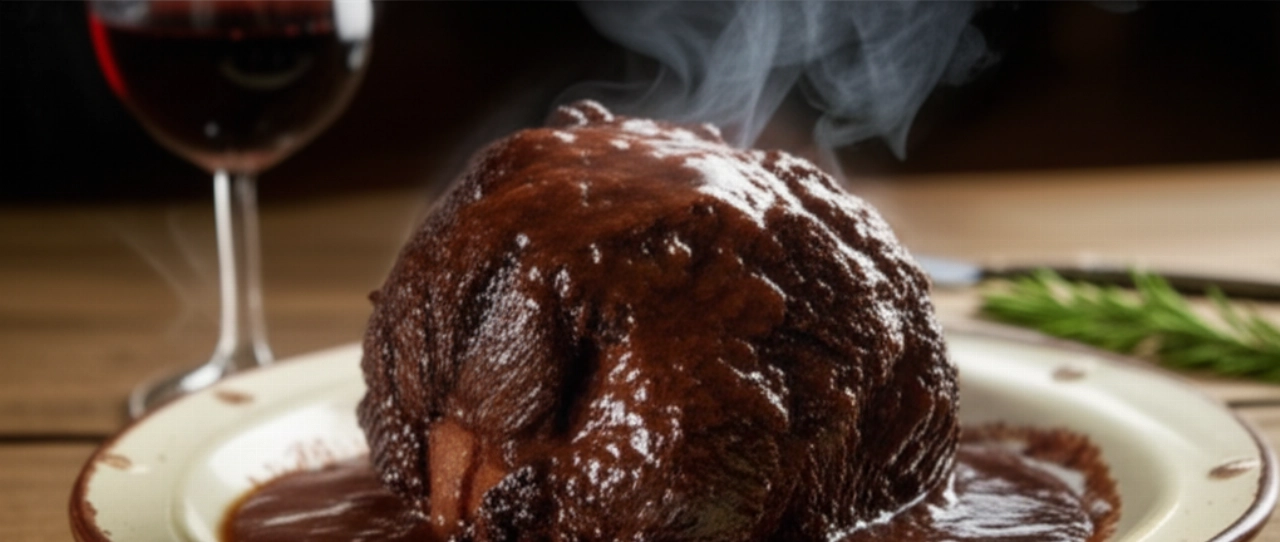Dreaming of bringing to the table a Piedmontese Bonet so velvety it melts in your mouth, with that unmistakable aroma of cocoa, amaretti, and a touch of rum? A dessert that tastes of home, tradition, and those heartwarming family Sundays?
But how many times have you tried to prepare it, only for the caramel to burn, the pudding to turn out too liquid, or, worse, grainy? Finding the true recipe, one that guarantees success and the authentic taste of grandma's cooking, can seem like an impossible mission, full of pitfalls and wasted precious ingredients.
Fear not! Make yourself comfortable. On this page, you won't just find a list of ingredients, but the definitive guide, rich in tricks and tips that only experience can provide, to prepare the most authentic and foolproof Piedmontese Bonet of your life. Success is guaranteed, and your dessert will be a triumph of flavors and textures that will leave everyone speechless.

THE STRATEGIC CORNER: Perfect Consistency and Foolproof Caramel
Our promise? No more puddings that won't unmold or bitter, burnt caramels! I'll guide you step by step to achieve a Bonet with a velvety, melt-in-your-mouth creaminess, that can be cut with a spoon, and a golden, delicious caramel, without the slightest risk of burning it. Just like the Piedmontese grandmothers used to make, with their wisdom and their little, big secrets.

Ingredients for a Perfect Bonet: The Choice That Makes the Difference
For a Bonet that lives up to its reputation, the quality of the ingredients is essential. It's not just a list, but a thoughtful selection to guarantee you the best result.
- Eggs (whole): We will use very fresh eggs, preferably with yellow yolks. They are the base of our pudding's structure and contribute to its richness. Don't worry about the consistency; the right balance with other ingredients will make them perfect.
- Whole Milk: Whole milk is irreplaceable for its creaminess. Do not use skim or partially skimmed milk, as you would deprive the Bonet of its unmistakable softness and enveloping flavor.
- Granulated Sugar: For both the pudding and the caramel. For the caramel, its purity is essential to prevent it from crystallizing.
- Unsweetened Cocoa Powder: Choose a high-quality cocoa, with an intense color and a strong aroma. It will be the aromatic heart of your Bonet, giving that slightly bitter aftertaste that balances the sweetness.
- Dry Amaretti Cookies: They are the crunchy and fragrant soul of the Bonet. They must be of good quality, crumbly, and with an intense bitter almond flavor. They should be finely crumbled, but not reduced to powder, to maintain a slight texture.
- Dark Rum (or Amaretto Liqueur): The alcoholic touch is essential to enhance the flavors and add depth to the Bonet. Dark rum is the traditional choice, but if you prefer a more delicate aroma, you can opt for an amaretto liqueur.
- A Pinch of Salt: A small secret to enhance all the flavors, especially that of cocoa. Don't underestimate it!

The 3 Common Mistakes in Preparing Bonet (and How to Avoid Them)
As grandma always told me, knowing the mistakes is the first step to not making them. Here are the most common pitfalls and how to avoid them for an impeccable Bonet:
- Burnt or Crystallized Caramel: This is the terror of many! The secret is to use a thick-bottomed pan and not stir the sugar once it starts to melt. Let it melt on its own over medium-low heat and only move the pan to distribute the heat. If you see crystals, add a teaspoon of water and continue to heat gently. Don't let it get too dark, otherwise it will be bitter.
- Grainy Pudding or with an Omelet Flavor: This happens when the eggs cook too quickly or are not well incorporated. Make sure the hot milk is poured in a thin stream over the beaten eggs, stirring continuously. And bain-marie cooking is ESSENTIAL for a gentle and uniform cooking that prevents excessive coagulation of the eggs.
- Bonet That Won't Unmold: Haste is the enemy of Bonet! It must cool completely, first at room temperature and then in the refrigerator for at least 4-6 hours, even better overnight. The cold will make it compact and easy to unmold. Also, be sure to butter and sugar the mold well before pouring the caramel.
The Magic Touch: The Secret My Grandmother Passed Down to Me
My grandmother, when preparing Bonet, had a small ritual. After crumbling the amaretti, she would always set aside a small portion, the coarser ones, to add them only at the very end, just before pouring the mixture into the mold. She said that this way, in addition to the creaminess, you would also feel a bit of crunchiness, a surprise under your teeth. And she was right! This small gesture adds an extra dimension to the Bonet, a contrast of textures that makes it even more irresistible. Try it, and you'll feel the difference!
Let's Prepare Bonet Together: The Step-by-Step Guide
Ingredients:
- 150 g granulated sugar (for caramel) + 100 g (for pudding)
- 500 ml whole milk
- 4 medium whole eggs
- 30 g unsweetened cocoa powder
- 80 g dry amaretti cookies
- 50 ml dark rum (or amaretto liqueur)
- A pinch of salt
Required Tools:
- Pudding mold (18-20 cm diameter)
- Thick-bottomed saucepan (for caramel)
- Large bowl
- Hand or electric whisk
- Fine-mesh sieve
- Larger pot for bain-marie
Procedure:
- Prepare the Caramel (calmly and carefully): In a thick-bottomed saucepan, pour the 150 g of granulated sugar. Place over medium-low heat. DO NOT stir. Let the sugar melt slowly and transform into an amber liquid. When it has reached a nice golden color (not too dark to avoid bitterness!), remove from heat. Immediately pour it into the pudding mold, rotating it to cover the bottom and sides well. Be careful, it's hot! Let it cool and solidify.
- Heat the Milk: In another saucepan, heat the whole milk until it just barely simmers. It shouldn't boil vigorously, just get well heated. Remove from heat and set aside.
- Prepare the Pudding Mixture: In a large bowl, whisk the whole eggs with the 100 g of granulated sugar and a pinch of salt. Whisk vigorously until you get a light and frothy mixture.
- Add Cocoa and Rum: Incorporate the sifted unsweetened cocoa into the egg and sugar mixture, stirring well to avoid lumps. Add the rum and stir again.
- Combine Milk and Amaretti: Pour the hot milk in a thin stream into the egg mixture, stirring continuously with the whisk. This step is crucial to temper the eggs and prevent them from cooking. Finally, add the crumbled amaretti (remember grandma's secret for the coarser ones!) and stir gently.
- Strain the Mixture (the chef's touch): For a Bonet with a velvety, lump-free consistency, strain the mixture through a fine-mesh sieve directly into the caramelized mold. This will remove any egg residue or amaretti that haven't perfectly dissolved.
- Cook in a Bain-Marie (the foolproof method): Preheat the oven to 180°C (static). Place the Bonet mold inside a larger baking dish. Pour hot water into the baking dish, reaching about half the height of the Bonet mold. Bake for about 50-60 minutes. The Bonet will be ready when, gently shaking the mold, the center is still slightly wobbly but the edges are firm.
- Cool and Unmold (patience pays off): Once cooked, remove the Bonet from the oven and from the water bath. Let it cool completely at room temperature. Then, cover it with plastic wrap and refrigerate for at least 4-6 hours, even better overnight. When it's well chilled and firm, gently run a thin-bladed knife along the edges of the mold to loosen it. Place a serving plate over the mold and flip it over with a decisive motion. The Bonet will slide out, enveloped in its glossy caramel.
Tips and Frequently Asked Questions about Piedmontese Bonet
Can I use less rum or omit it entirely?
Rum is a characteristic element of Bonet and contributes to its unique flavor. If you don't want to use it, you can substitute it with the same amount of strong coffee or milk, but be aware that the aromatic profile will be slightly different. For children, you can use non-alcoholic rum or food flavorings.
Can I prepare Bonet in advance?
Absolutely yes! In fact, Bonet is one of those desserts that benefit from resting. Preparing it the day before and leaving it in the refrigerator overnight will enhance its consistency and flavors. It will be even better!
How can I store leftover Bonet?
Bonet can be stored in the refrigerator, covered with plastic wrap or in an airtight container, for 3-4 days. It is not advisable to freeze it, as its consistency may change.
Why did my Bonet turn out grainy?
Most likely, it's due to too rapid cooking or incorrect incorporation of hot milk into the eggs. Make sure to pour the milk in a thin stream and stir constantly, and always cook in a bain-marie for gentle and uniform cooking.
Can I use sweet cocoa instead of unsweetened?
It is not recommended. Unsweetened cocoa is essential to balance the sweetness of the sugar and amaretti, giving the Bonet its characteristic deep and slightly bitter flavor. Using sweet cocoa would result in an excessively cloying outcome.
A Masterpiece of Sweetness and Tradition
There you have it! Now you no longer just have a recipe, but all the secrets, tricks, and grandma's tips to bring to the table a Piedmontese Bonet that tastes of home, tradition, and love. A spoon dessert that will conquer everyone from the first bite.
Don't be afraid to experiment and make this wonderful dessert your own. Cooking is an act of creativity, and with this solid foundation, you'll see that applause will not be lacking. Every time you prepare it, you'll feel a bit of the magic and wisdom of our grandmothers.
Have you tried our recipe? We are very curious to see your masterpiece! Leave a comment below, tell us how it went, or share a photo on Instagram by tagging @CercaRicette.it. If you loved this Bonet, you can't miss our recipe for Panna Cotta, another Piedmontese classic, or for another traditional dessert like Zabaione. Your culinary adventure continues with us!





